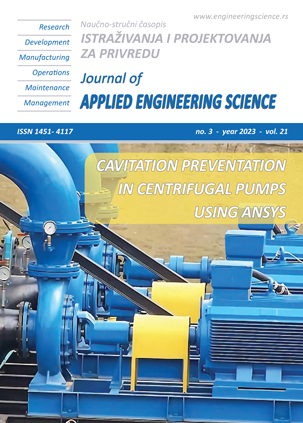INTEGRATING EXPERIMENTAL ANALYSIS AND MACHINE LEARNING FOR ASSESSING BOND PERFORMANCE AND CORROSION SEVERITY IN REINFORCED CONCRETE STRUCTURES
Abstract
This study presents a comprehensive investigation into the effects of corrosion on bond performance and mechanical properties of steel-concrete interfaces by combining experimental analysis with machine learning techniques. A total of 32 concrete prisms with varying water-cement (w/c) ratios were prepared and subjected to an accelerated corrosion process. Corrosion severity was assessed through visual inspection and weight loss measurements, while mechanical properties were evaluated through the pull-out tests. Experimental results showed that the residual bond load decreased to 77% and 81% for w/c ratios of 0.37 and 0.47, respectively, after accelerated corrosion. Additionally, corroded prisms exhibited significantly reduced residual toughness and stiffness compared to their non-corroded counterparts. To establish a correlation between bond slip and corrosion severity, a machine learning algorithm was developed and implemented. The algorithm achieved an accuracy of 100% for both studied w/c ratios and remarkably low costs after optimization (4.548 for w/c ratio of 0.37 and 3.445for w/c ratio of 0.47). This integrated approach provides valuable insights for future infrastructure assessment and maintenance efforts. In conclusion, this study combines laboratory findings with real-world applications. It provides a thorough understanding of the relationship between corrosion and bond performance in reinforced concrete structures. Maintaining the structural integrity and safety of reinforced concrete structures in corrosive environments can be aided by the results of this research.)
References
Bastidas-Arteaga, E. and Stewart, M.G. (2015). Damage risks and economic assessment of climate adaptation strategies for design of new concrete structures subject to chloride-induced corrosion. Structural Safety, 52, pp.40–53. doi:https://doi.org/10.1016/j.strusafe.2014.10.005.>
Michel, A., Otieno, M., Stang, H. and Geiker, M.R. (2016). Propagation of steel corrosion in concrete: Experimental and numerical investigations. Cement and Concrete Composites, 70, pp.171–182. doi:https://doi.org/10.1016/j.cemconcomp.2016.04.007.>
Marra, E., Zirkelbach, D. and Künzel, H.M. (2015). Prediction of Steel Corrosion in Porous Building Materials by Means of a New Hygrothermal Model. Energy Procedia, 78, pp.1299–1304. doi:https://doi.org/10.1016/j.egypro.2015.11.144.>
Lin, H., Zhao, Y., Feng, P., Ye, H., Ozbolt, J., Jiang, C. and Yang, J.-Q. (2019). State-of-the-art review on the bond properties of corroded reinforcing steel bar. Construction and Building Materials, 213, pp.216–233. doi:https://doi.org/10.1016/j.conbuildmat.2019.04.077.>
Lin, H., Zhao, Y., Feng, P., Ye, H., Ozbolt, J., Jiang, C. and Yang, J.-Q. (2019). State-of-the-art review on the bond properties of corroded reinforcing steel bar. Construction and Building Materials, 213, pp.216–233. doi:https://doi.org/10.1016/j.conbuildmat.2019.04.077.>
Yalciner, H., Eren, O. and Sensoy, S. (2012). An experimental study on the bond strength between reinforcement bars and concrete as a function of concrete cover, strength and corrosion level. Cement and Concrete Research, 42(5), pp.643–655. doi:https://doi.org/10.1016/j.cemconres.2012.01.003.>
Kearsley, E.P. and Joyce, A. (2014). Effect of corrosion products on bond strength and flexural behaviour of reinforced concrete slabs. Journal of The South African Institution of Civil Engineering, 56(2), pp.21–29.
Kivell, A., Palermo, A. and Scott, A.L. (2012). Corrosion Related Bond Deterioration and Seismic Resistance of Reinforced Concrete Structures. doi:https://doi.org/10.1061/9780784412367.166.>
Lee, H.-S., Noguchi, T. and Tomosawa, F. (2002). Evaluation of the bond properties between concrete and reinforcement as a function of the degree of reinforcement corrosion. Cement and Concrete Research, 32(8), pp.1313–1318. doi:https://doi.org/10.1016/s0008-8846(02)00783-4.>
Aydin, Y., Bekdaş, G., Işıkdağ, Ü., Nigdeli, S.M. (2023). The State of Art in Machine Learning Applications in Civil Engineering. In: Bekdaş, G., Nigdeli, S.M. (eds) Hybrid Metaheuristics in Structural Engineering. Studies in Systems, Decision and Control, vol 480. Springer, Cham. https://doi.org/10.1007/978-3-031-34728-3_9.>
Kang, M.-C., Yoo, D.-Y. and Gupta, R. (2021). Machine learning-based prediction for compressive and flexural strengths of steel fiber-reinforced concrete. Construction and Building Materials, 266, p.121117. doi:https://doi.org/10.1016/j.conbuildmat.2020.121117.>
Aydın, Y., Bekdaş, G., Nigdeli, S.M., Isıkdağ, Ü., Kim, S. and Geem, Z.W. (2023). Machine Learning Models for Ecofriendly Optimum Design of Reinforced Concrete Columns. Applied Sciences, 13(7), p.4117. doi:https://doi.org/10.3390/app13074117.>
Angst, U.M. (2019). Predicting the time to corrosion initiation in reinforced concrete structures exposed to chlorides. Cement and Concrete Research, 115, pp.559–567. doi:https://doi.org/10.1016/j.cemconres.2018.08.007.>
Hoang, N.-D., Chen, C.-T. and Liao, K.-W. (2017). Prediction of chloride diffusion in cement mortar using Multi-Gene Genetic Programming and Multivariate Adaptive Regression Splines. Measurement, 112, pp.141–149. doi:https://doi.org/10.1016/j.measurement.2017.08.031.>
Anike, E.E., Saidani, M., Ganjian, E., Tyrer, M. and Olubanwo, A.O. (2020). Evaluation of conventional and equivalent mortar volume mix design methods for recycled aggregate concrete. Materials and Structures, 53(1). doi:https://doi.org/10.1617/s11527-020-1457-3.>
Jean-Denis Cornillot and Milligan, S. (2016). Annual Book of ASTM Standards. (1).

